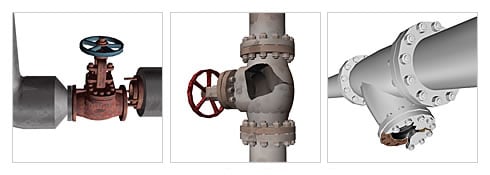Consequences of and Solutions to Water Hammer
Water hammer is a phenomenon that can be either a mild nuisance or a severe problem. It is usually considered a safety hazard. The extreme pressure caused by water hammer can blow out gaskets and cause pipes to suddenly rupture, causing serious injury to anyone nearby.

Identifying Water Hammer
Usually, you can identify water hammer by a loud banging or hammering sound coming from pipes, especially after quickly shutting off a water source. This sound is caused by the pressure shockwave hitting some kind of blockage like a closed valve or joint at a high force. The noise can sometimes be deafening, and can sometimes become a major source of stress, especially for any nearby workers.
Damage Caused by Water Hammer
Recurring cases of water hammer, however, are more than just an annoyance. Water hammer can cause serious damage to pipelines, pipe joins gaskets, and all other components of the system like flow meters and pressure gauges. On contact, these pressure spikes can easily exceed five to ten times the working pressure of the system, placing a tremendous amount of stress on the system.
Water hammer can also cause leaks at the joints in the system, crack pipe walls and deform piping support systems. It can be quite expensive to repair or replace damaged pipeline components and equipment. Worse, the cost can grow exponentially if the spill results in an environmental issue.
Solutions to Water Hammer
Water hammer can be prevented or reduced in a number of ways, depending on its cause. Educating and training operators is one of the simplest ways to minimize water hammer caused by hydraulic shock. Training allows operators to learn the importance of properly opening and closing manual or actuated valves, and can take care to minimize the effects of water hammer. Operators can also be more careful in safely opening and closing quarter turn valves like ball valves, butterfly valves, and plug valves.
Another option of reducing the pressure spikes caused by water hammer are water hammer arrestors. Water hammer resistors are components of the piping system that reduce the noise and stress to pipeline systems by absorbing the shock. Just make sure to size and install them properly, otherwise they will not be as effective.
Valves Can Reduce Water Hammer
You can also install check valves in vertical pipe lines. These include swing checks, tilting discs, and double door check valves, all of which can be made to operate in a vertical line. Keep in mind that these will not prevent reversing flow in this orientation, in which case a Silent Check Valve is the best option.
Sometimes the sudden closure of swing check, tilting disc and double door check valves can cause hydraulic shock. You can prevent this by changing these valves with silent of non-slam check valves, such as the kind manufactured by DFT. Rather than reversing flow, silent check valves close when the differential pressure across the closure member of the valve decreases.
Water hammer can be caused when valves slam shut; silent check valves are far less likely to cause this to happen. The valve fully closes when the differential pressure across the disc approaches the cracking pressure of the valve. The fluid then decelerates and decreases momentum before the valve is fully shut. This also ensures that the fluid does not reverse direction.












Comments are closed